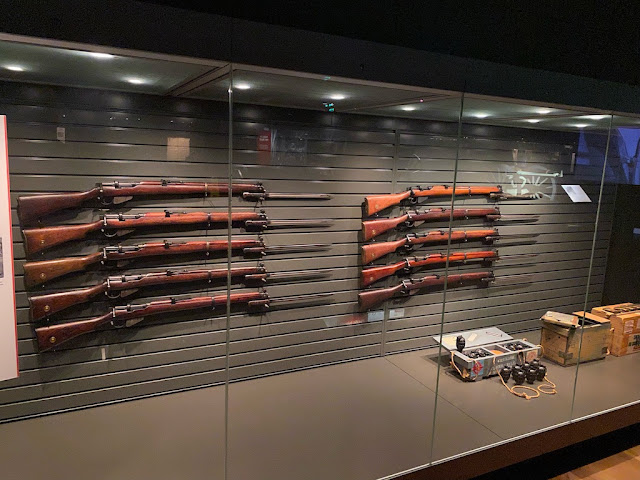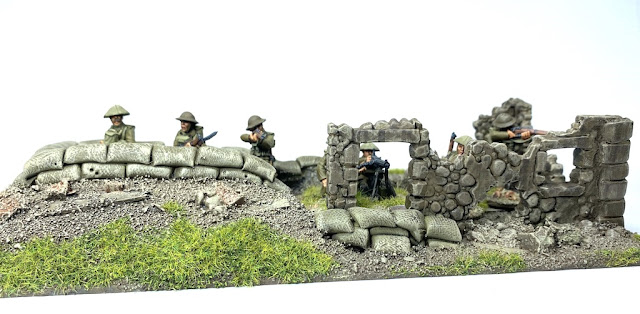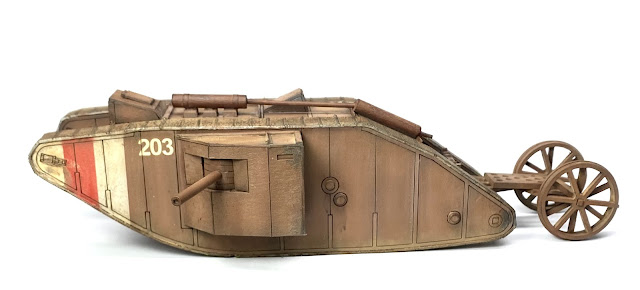My British force for the First World War, like my German force, is based around the period 1916-18 and is intended for platoon level actions. It's a period of the war that sees a significant change in the way the British Army platoon was structured and fought, one with many implications for the war that was to follow in 1939-45.
My miniatures all come from the Great War Miniatures range. In terms of appearance the most noticeable difference in the uniform and equipment from the early period of the war is the adoption of the steel helmet.
Yet while the infantryman's rifle remained unchanged throughout the war the way the platoon operated was fundamentally altered with the arrival of a light machine gun in the form of the Lewis gun. The platoon's inherent fire support also increased with greater amounts of hand grenades and the ability of the rifle grenade to extend their range. The platoon of this later period could not only generate more firepower but was also far more flexible as a tactical unit. Nothing sums that up better than SS-143 the tactical pamphlet published by the General Staff in 1917 - "Instructions for the Training of Platoons for Offensive Action". This certainly makes for an interesting period from an historical and wargaming perspective.
While my scale of preference for my Second World War platoon level games is 20mm I found that the much closer terrain during the more static periods of the First World War make it possible to game this one in 28mm without a 6x4 table feeling over crowded.
The Great War Miniatures figures are lovely sculpts with plenty of character.
I have chosen to paint the helmets in a medium brown colour despite the fact they were issued in a more green colour. From what I’ve seen once in service the helmets soon lost that initial colour. These on display at the Imperial War Museum and National Army Museum in London are closer to the colour I’ve been trying to capture.
The officers are carrying the Webley service revolver seen here at the Australian Army Infantry Museum alongside the German equivalent, the Luger.
In most cases the NCOs are armed with the standard SMLE rifle.
The platoon at this stage of the war was normally composed of four sections - Bombers, Lewis gun(s), Rifle Grenades and Riflemen. In its simplest form it was designed so that the Lewis gun and rifle grenades could provide supporting and suppressing fire, while the riflemen and bombers were the manoeuvre elements. Once in position the bombers would shower a defensive position with grenades while the riflemen went in to clear the position.

The Lewis gunners come with a gunner figure and a No2 carrying the ammunition. I think the only thing I'd have liked to see in this group is a figure actually firing the weapon.
If the photograph below from 1918 is anything to go by then the Lewis guns could well have been given to the biggest or strongest men in the platoon. The soldier carrying the gun here stands well above the average height of the rest of the unit.
While a similar length to the German MG08/15, the Lewis was about 1.5kg lighter. You can see the two side by side in this display at the Australian Army Infantry Museum.
GW Miniatures have a prone and kneeling rifle grenadier.
There’s a good example of the rifle grenade attachment and a rifle grenade on display in the Imperial War Museum.
The bombers from Great War Miniatures are mostly armed with the No36 grenade.
The bombers' webbing includes additional pouches for grenades like these on display at the Imperial War Museum.
The figures carry a range of grenades including the No36 grenade as seen here at the Australian Infantry Museum.
Last but not least, there is the section of riflemen.
The men all have the 1908 pattern webbing and ammunition pouches as do all the other ranks and NCOs.
The display at the Australian Army Infantry Museum also includes a set of the same webbing made in leather. Given the plentiful amount of leather in Australia due to the large cattle industry it was decided the webbing for the Australians should be made of leather instead of fabric. As it turned out leather was ill-suited to the damp conditions of France and Belgium and was soon replaced with fabric.
They all have the obligatory gas masks carried in a bag on the chest. There’s an excellent example of one in the Imperial War Museum.
The Australian Army Infantry Museum has an excellent display showing how the firepower of an infantry section changed between 1918 and 1945. The image below is the 1918 display. Ten rifles representing the fire power of a ten man section which could generate in the region of 200 rounds per minute. The adjoining display case shows the firepower of a 1945 section. With only eleven men but the addition of a Bren gun and two submachine guns this section was capable of generating 400 rounds per minute. Quite a demonstration of how the addition of automatic weapons can increase firepower.
That gives me the core infantry platoon. For support there is a Vickers machine gun, although as a rule these were grouped together rather than parcelled out individually.
Here is one on display at the Australian Army Infantry Museum:
Great War Miniatures do a lovely group of trench raiders that are full of character and perfect for a small trench raiding game.
More powerful support comes in the form of a 13 pounder artillery piece. While artillery was a major feature of the war at a platoon level game this is likely to be the heaviest piece to make an appearance on a gaming table, all other artillery effects would be abstracted in various ways.
The Imperial War Museum has a 13 pounder gun and limber on display.
One of the key features of this later period of the war was the advent of tank. While their impact cannot be ignored, neither can it be overstated. At places like Cambrai and the following year at Amiens they demonstrated their potential but these early designs also suffered from mechanical breakdowns and a myriad of other issues. They certainly helped the infantry break in to a defensive position but their lack of mobility meant they were not the sort of breakthrough weapons as we might understand them from the next war.
As all my Second World War games are in 20mm (1/72) I'm used to having a great choice of tanks at a very reasonable price. I should be honest, I have a lot. The price of 28mm tanks came as something of a shock and so I was tempted to purchase an MDF model of a MkI tank from Warbases at a fraction of the cost of a resin model.
It's true that you tend to get what you pay for and the MDF kit was very basic. I carried out a bit of extra work to try and lift it but the whole thing is a compromise. First of all it's a very early model of the tank and by 1917-18 was replaced with later variants. So although I've painted it in colours more appropriate for 1918 it's a variant that is very unlikely to have been in action at that time. It's the price you pay when you try to save money!
I based the colour scheme on this MkV tank in the Tank Museum at Bovington.
That said, I'm happy with the overall result and you can follow the complete build and painting in
this post if you are interested in learning more.
I have been using this force for games of either Through the Mud & the Blood from Too Fat Lardies or their First World War variant for Chain of Command. They included four games of a home grown scenario I designed to run as a participation game in the Lard Zone at CanCon 2024.
We also played a few games at the club including one set in a ruined village where I had to shoehorn the 28mm figures into terrain I had build for my 20mm games. I think we just about managed to make it work.


























































What a superb post! Loads of great information and some top notch figures painted so very nicely, quite superb all round!
ReplyDeleteThanks very much, glad you found it useful.
DeleteA very fine post and advert for a much neglected period. I particularly like your reinforced ruin position I shall certainly steal that idea. Hopefully Richard will pick up his WWI version of CoC he trialled at the Partizan show a few years ago.
ReplyDeleteThanks Phil. It is indeed a neglected period and a very misunderstood one with gamers, which is probably why Richard is not rushing to produce a specific rule set, I suspect he's not convinced there is sufficient demand to warrant the investment. I suspect he's right. Shame.
DeleteFantastic article, as always. Wondered if you'd seen this? https://www.goonhammer.com/chain-of-command-great-war-author-interview/
DeleteI haven’t seen that post but Alex did send me a draft version of his CoC adaptation a few months ago.
DeleteThis is a great post AND a great collection of miniatures. Stop crushing the internet, you're making the rest of us look bad. 😁
ReplyDelete(nice job I enjoyed this post very much)
Ha ha, I'm not even convinced it's crushing our very small corner of the internet, never mind the rest of it. Glad you liked it though and I'll take all compliments!
DeleteAwesome as usual! Did you scratch build the trench or is it a kit? If the former will you be doing a tutorial?PLEASE!
ReplyDeleteThanks Dick. Yes the trench was scratchbuilt. You can see the techniques I used to make it in this blog post: http://thetacticalpainter.blogspot.com/2023/08/terrain-making-using-warlord-games.html
DeleteNicely done, interesting and informative. Those trench raiders look a right dodgy bunch of geezers. It's a little odd how there seems to be few Lewis gunner figures in an actual firing pose no matter which scale you choose.
ReplyDeleteThanks. Yes the trench raiders do look the part, don't they? I think the problem with Lewis gunners is if you sculpt them so they are firing from within a trench it limits what can be done with them otherwise. In the same way a prone firer is fine outside of a trench but not in one. I suspect the standing/walking figure is something of a compromise between the two.
DeleteGreat stuff and a very informative post.
ReplyDeleteAll good stuff. One of my grandfathers was a Lewis gunner in the 1/7 Cheshires on the Western Front in 1918. It would have been logical to make the tallest men the Lewis gunners, but it certainly didn't always apply, as my grandfather was about 5' 5"! He was made an instructor on the weapon, and used to be able to recite the various stoppage drills, which were taught and learned by rote in those days. An interesting point he mentioned was that bayonets would have been of little use to the Lewis crew as secondary weapons, so they were supplied with Mills bombs. As if they didn't already have enough to carry about! He won the MM and was twice mentioned in dispatches, mainly for having killed a lot of Germans with his gun, something that never sat easily with him in later years.
ReplyDeleteHi, the british lads looking great ! I would like to know what kind of colour did you use (avveljo ? and wich number/ name of colour, or did you mix the colour ? It would be great to send me some information about. Cheers Ingo
ReplyDeleteI mean Vallejo
DeleteThanks. All paints are Vallejo Model Colour. The uniform is English Uniform, highlights are that colour mixed 50:50 with Khaki. Webbing is Khaki then highlighted with a mix of that and Ivory. Helmets are German Med Brown. Lightened with Khaki and dry brushed with Iraqi Sand. The Jerkins are Flat Brown highlighted with Red Leather.
Delete